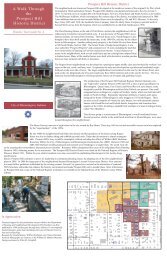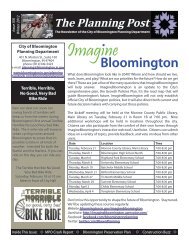Peak Oil Task Force Report - City of Bloomington - State of Indiana
Peak Oil Task Force Report - City of Bloomington - State of Indiana
Peak Oil Task Force Report - City of Bloomington - State of Indiana
Create successful ePaper yourself
Turn your PDF publications into a flip-book with our unique Google optimized e-Paper software.
The <strong>City</strong> should establish or encourage the establishment <strong>of</strong> a city‐wide car sharing<br />
program. Car sharing reduces the need for personal vehicle ownership and the demand for<br />
parking. It also stands to save residents money and would allow local businesses and non‐<br />
pr<strong>of</strong>its to economize on their fleets.<br />
4. Land use: make the best <strong>of</strong> the existing built environment.<br />
The goal <strong>of</strong> post‐peak land use planning with regard to transportation is bringing daily<br />
necessities closer to where people live, so that biking, walking and transit become more<br />
feasible and automobile trips become shorter. This can be done by facilitating changes in<br />
land use toward increased density and mixed use. Since the built environment changes<br />
rather slowly, the priority within the first five years is to make the best <strong>of</strong> what we have, by<br />
starting the process <strong>of</strong> changing how existing structures can be used.<br />
As outlined in the previous chapter on Land Use, one obvious improvement would be to<br />
encourage even more mixed uses in our zoning laws, making it possible for small<br />
businesses to locate closer to where their customers live, thus reducing the need for<br />
automobile trips and facilitating walking, biking, and public transit. Another improvement<br />
would be to allow more flexibility for home owners to divide up an existing building into<br />
smaller units, to add wings, or to add granny flats, in order to create additional dwelling<br />
units. 172 These measures increase population density, and may meet a growing need for<br />
fairly inexpensive housing close to activity nodes, as more people want to live closer to<br />
where they work and shop. Besides facilitating walking and biking, increasing density is a<br />
very important aspect <strong>of</strong> making public transportation cost‐effective and attractive for both<br />
riders and providers. To start that process, community involvement and support are<br />
necessary. Ideally, the process <strong>of</strong> allowing a more flexible use <strong>of</strong> the existing built<br />
environment should be propelled from the “bottom up.”<br />
172 Permitting granny flats in residential districts has been a source <strong>of</strong> much local controversy. Please see the<br />
Housing chapter for further discussion <strong>of</strong> granny flats.<br />
<strong>Report</strong> <strong>of</strong> the <strong>Bloomington</strong> <strong>Peak</strong> <strong>Oil</strong> <strong>Task</strong> <strong>Force</strong><br />
140









